Evaluation of Urban Ecological Environment Quality Based on Improved RSEI and Driving Factors Analysis
Abstract
:1. Introduction
2. Materials and Methods
2.1. Study Area
2.2. Data Sources and Preprocessing
2.3. Methodology
2.3.1. Constructing the IRSEI and RSEI
- (1)
- RSEI model
- (2)
- IRSEI model
2.3.2. Geographically Weighted Regression
3. Results
3.1. Changes in the Indices
3.2. Comparative Analysis of IRSEI and RSEI
3.3. Spatiotempral Distribution of IRSEI
3.4. Analysis of Ecological Environmental Quality Driver
3.4.1. Global Spatial Autocorrelations
3.4.2. Results of GWR-Based Regression Coefficients of Driving Factors
4. Discussion
4.1. Calculation of IRSEI
4.2. Driving Forces of Ecological Environment Quality
5. Conclusions
Author Contributions
Funding
Institutional Review Board Statement
Informed Consent Statement
Data Availability Statement
Acknowledgments
Conflicts of Interest
References
- Zhang, T.; Yang, R.; Yang, Y.; Li, L.; Chen, L. Assessing the Urban Eco-Environmental Quality by the Remote-Sensing Ecological Index: Application to Tianjin, North China. ISPRS Int. J. Geo-Inf. 2021, 10, 475. [Google Scholar] [CrossRef]
- Zhang, H.; Yin, Y.; An, H.; Lei, J.; Li, M.; Song, J.; Han, W. Surface urban heat island and its relationship with land cover change in five urban agglomerations in China based on GEE. Environ. Sci. Pollut. Res. 2022, 29, 82271–82285. [Google Scholar] [CrossRef]
- Yin, Y.; Zhang, H.; An, H.; Lei, J.; Li, M.; Song, J.; Han, W. Heat island characteristics and influencing factors of urban agglomerations in the Yangtze River Economic Zone based on gee. J. Ecol. 2023, 1, 1–13. [Google Scholar]
- Zhuang, Q.; Wu, S.; Yan, Y.; Niu, Y.; Yang, F.; Xie, C. Monitoring Land Surface Thermal Environments under the Background of Landscape Patterns in Arid Regions: A Case Study in Aksu River Basin. Sci. Total Environ. 2020, 710. [Google Scholar] [CrossRef] [PubMed]
- Jiang, L.; Liu, Y.; Wu, S.; Yang, C. Analyzing ecological environment change and associated driving factors in China based on NDVI time series data. Ecol. Indic. 2021, 129, 107933. [Google Scholar] [CrossRef]
- Li, Y.; Cao, Z.; Long, H.; Liu, Y.; Li, W. Dynamic analysis of ecological environment combined with land cover and NDVI changes and implications for sustainable urban–rural development: The case of Mu Us Sandy Land, China. J. Clean. Prod. 2017, 142, 697–715. [Google Scholar] [CrossRef]
- Xu, H.Q. A Remote Sensing Urban Ecological Index and Its Application. Acta Ecol. Sin. 2013, 33, 7853–7862. [Google Scholar]
- Zhang, Y.; She, J.; Long, X.; Zhang, M. Spatio-temporal evolution and driving factors of eco-environmental quality based on RSEI in Chang-Zhu-Tan metropolitan circle, central China. Ecol. Indic. 2022, 144, 109436. [Google Scholar] [CrossRef]
- Geng, J.; Yu, K.; Xie, Z.; Zhao, G.; Ai, J.; Yang, L.; Yang, H.; Liu, J. Analysis of Spatiotemporal Variation and Drivers of Ecological Quality in Fuzhou Based on Rsei. Remote Sens. 2022, 14, 4900. [Google Scholar] [CrossRef]
- Gao, P.; Kasimu, A.; Zhao, Y.; Lin, B.; Chai, J.; Ruzi, T.; Zhao, H. Evaluation of the Temporal and Spatial Changes of Ecological Quality in the Hami Oasis Based on RSEI. Sustainability 2020, 12, 7716. [Google Scholar] [CrossRef]
- Nong, L.; Wang, J. Dynamic monitoring of ecological environment quality in Kunming based on rsei model. J. Ecol. 2020, 39, 2042–2050. [Google Scholar]
- Yang, W.; Zhou, Y.; Li, C. Assessment of Ecological Environment Quality in Rare Earth Mining Areas Based on Improved Rsei. Sustainability 2023, 15, 2964. [Google Scholar] [CrossRef]
- Liu, Y.; Dang, C.-Y.; Yue, F.; Lv, C.-G.; Qian, J.-X.; Zhu, R. Comparative analysis of improved remote sensing ecological index and rsei. J. Remote Sens. 2022, 26, 683–697. [Google Scholar]
- Hua, G.; Cen, H.; Shen, S.; Meng, Z.; Wu, J.; Shen, Z. Huaihai Blue Book: Huaihai Economic Zone Development Research Report (2020~2021); Social Sciences Academic Press: Beijing, China, 2021. [Google Scholar]
- Pariha, H.; Zan, M.; Alimjia, K. Remote sensing evaluation of ecological environment in Urumqi city and analysis of driving factors. Arid. Zone Res. 2021, 38, 1484–1496. [Google Scholar]
- An, M.; Xie, P.; He, W.; Wang, B.; Huang, J.; Khanal, R. Spatiotemporal change of ecologic environment quality and human interaction factors in three gorges ecologic economic corridor, based on RSEI. Ecol. Indic. 2022, 141, 109090. [Google Scholar] [CrossRef]
- Xue, C.-L.; Zhang, H.-Q.; Zou, T.; Sun, Z.-J.; Cheng, H.-Y. Ecological quality of the Sino-Lao railroad economic corridor and its relationship with human activities. J. Appl. Ecol. 2021, 32, 638–648. [Google Scholar]
- Cai, P.; Li, F.; Wang, Z.; Zhao, H. Correlation analysis of ground temperature and air temperature changes in Jining, Shandong Province, 1961–2015. Glacial Permafr. 2016, 38, 1538–1543. [Google Scholar]
- Dong, X.-G.; Li, S.-L.; Shi, Z.-B.; Qiu, C. Change Characteristics of Agricultural Climate Resources in Recent 50 Years in Shandong Province, China. Ying Yong Sheng Tai Xue Bao = J. Appl. Ecol. 2015, 26, 269–277. [Google Scholar]
- Alexander, C. Normalised difference spectral indices and urban land cover as indicators of land surface temperature (LST). Int. J. Appl. Earth Obs. Geoinf. 2019, 86, 102013. [Google Scholar] [CrossRef]
- Xin, W.J.; Ma, J.M.; Wang, Y.Q. Ecological environment quality evaluation of Guilin city based on remote sensing ecological index. J. Guangxi Norm. Univ. (Nat. Sci. Ed.) 2022, 40, 1–14. [Google Scholar]
- Fotheringham, A.S.; Brunsdon, C.; Charlton, M. Geographically Weighted Regression: The Analysis of Spatially Varying Relationships; John Wiley & Sons: Hoboken, NJ, USA, 2003. [Google Scholar]
- Chen, X.; Zeng, X.; Zhao, C.; Qiu, R.; Zhang, L.; Hou, X.; Hu, X. Analysis of ecological effects of road networks based on remote sensing ecological indices—A case study of Fuzhou City. J. Ecol. 2021, 41, 4732–4745. [Google Scholar]
- Xue, R.; Yu, X.; Li, D.; Ye, X. Exploring the influence of environmental heterogeneity on the spatial use of giant pandas in the Qinling Mountains based on a geographically weighted regression model. J. Ecol. 2020, 40, 2647–2654. [Google Scholar]
- Shan, W.; Jin, X.; Ren, J.; Wang, Y.; Xu, Z.; Fan, Y.; Gu, Z.; Hong, C.; Lin, J.; Zhou, Y. Ecological environment quality assessment based on remote sensing data for land consolidation. J. Clean. Prod. 2019, 239, 118126. [Google Scholar] [CrossRef]
- Shan, W.; Jin, X.; Meng, X.; Yang, X.; Xu, Z.; Gu, Z.; Zhou, Y. Dynamic monitoring of ecological and environmental quality of land remediation based on multi-source remote sensing data. J. Agric. Eng. 2019, 35, 234–242. [Google Scholar]
- A Comparative Study on the Effect of Qi-Lu Cultural Differences on Regional Economic Development in Shandong. In Proceedings of the 2020 International Conference on Big Data Application & Economic Management (ICBDEM 2020), Guiyang, China, 27–28 March 2020.
- Yao, Z.; Jiang, C.; Shan-Shan, F. Effects of urban growth boundaries on urban spatial structural and ecological functional optimization in the Jining Metropolitan Area, China. Land Use Policy 2022, 117, 106113. [Google Scholar] [CrossRef]
- Yang, G.; Lu, N.; Xiao, X.; Ziegler, M. Analysis of Land Use in Jining City. E3S Web Conf. 2020, 198, 04024. [Google Scholar]
- Wang, Y.; Zhao, Y.; Jiao, L.; Zou, Y. Changes in vegetation cover and influencing factors in Jining City from 2005–2016. J. Jinan Univ. (Nat. Sci. Ed.) 2018, 32, 171–177. [Google Scholar]
- Krueger, H.; McLean, D.; Williams, D. Construction of Ecological Security Pattern Based on Ecological Sensitivity Assessment in Jining City, China. Prog. Exp. Tumor Res. 2008, 40, 1–6. [Google Scholar] [PubMed]
- Guo, J.; Hu, Z.; Yuan, D.; Liang, Y.; Li, P.; Yang, K.; Fu, Y. Dynamic Evolution of Cultivated Land Fragmentation in Coal Mining Subsidence Area of the Lower Yellow River Basin: A Case Study of Jining City, Shandong Province. J. China Coal. Soc. 2021, 46, 3039–3055. [Google Scholar]
- Shi, Y.; Guo, C.; Li, S.; Lu, F. Planning practice of ecological belt around Jining city. Planner 2018, 34, 52–58. [Google Scholar]
- Weerasinghe, R.; Han, X.; Fang, C. Study on the Dilemma and Countermeasures of Rural Environmental Pollution Control under the Background of Rural Revitalization Strategy. E3S Web Conf. 2021, 237, 01030. [Google Scholar]
- Zhang, S.-Y.; Fan, Y.-F.; Yan, L.; Xiao, X.-Z.; Li, H. A study on the spatial and temporal changes of ecological quality and its driving forces in Shaanxi Province in the past 20 years based on long time series modis. J. Soil Water Conserv. 2023, 37, 111–119+198. [Google Scholar]
- Wang, S.; Gao, S.; Chen, J. A study of spatial heterogeneity of factors influencing haze pollution in Chinese cities based on the gwr model. Geogr. Stud. 2020, 39, 651–668. [Google Scholar]
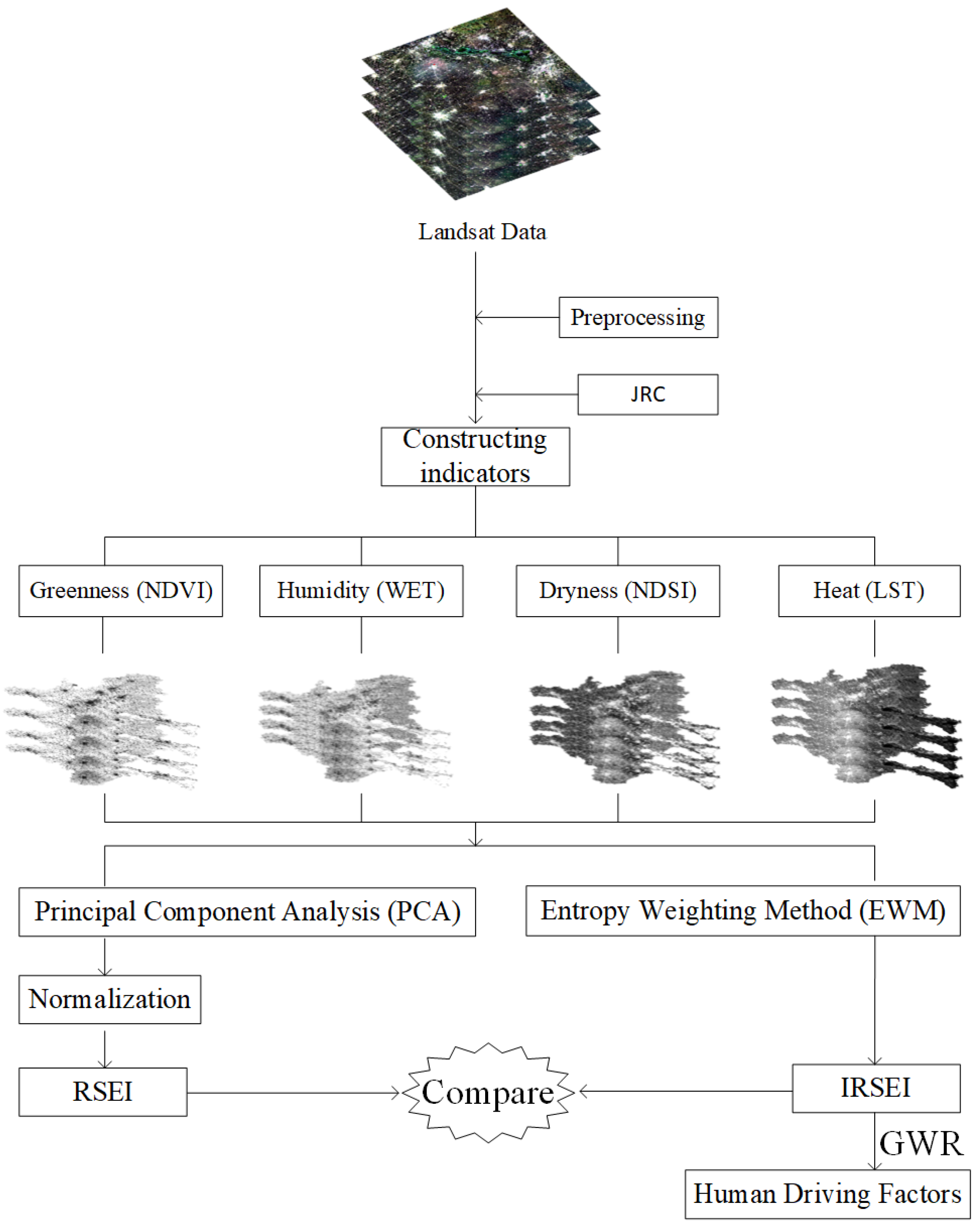
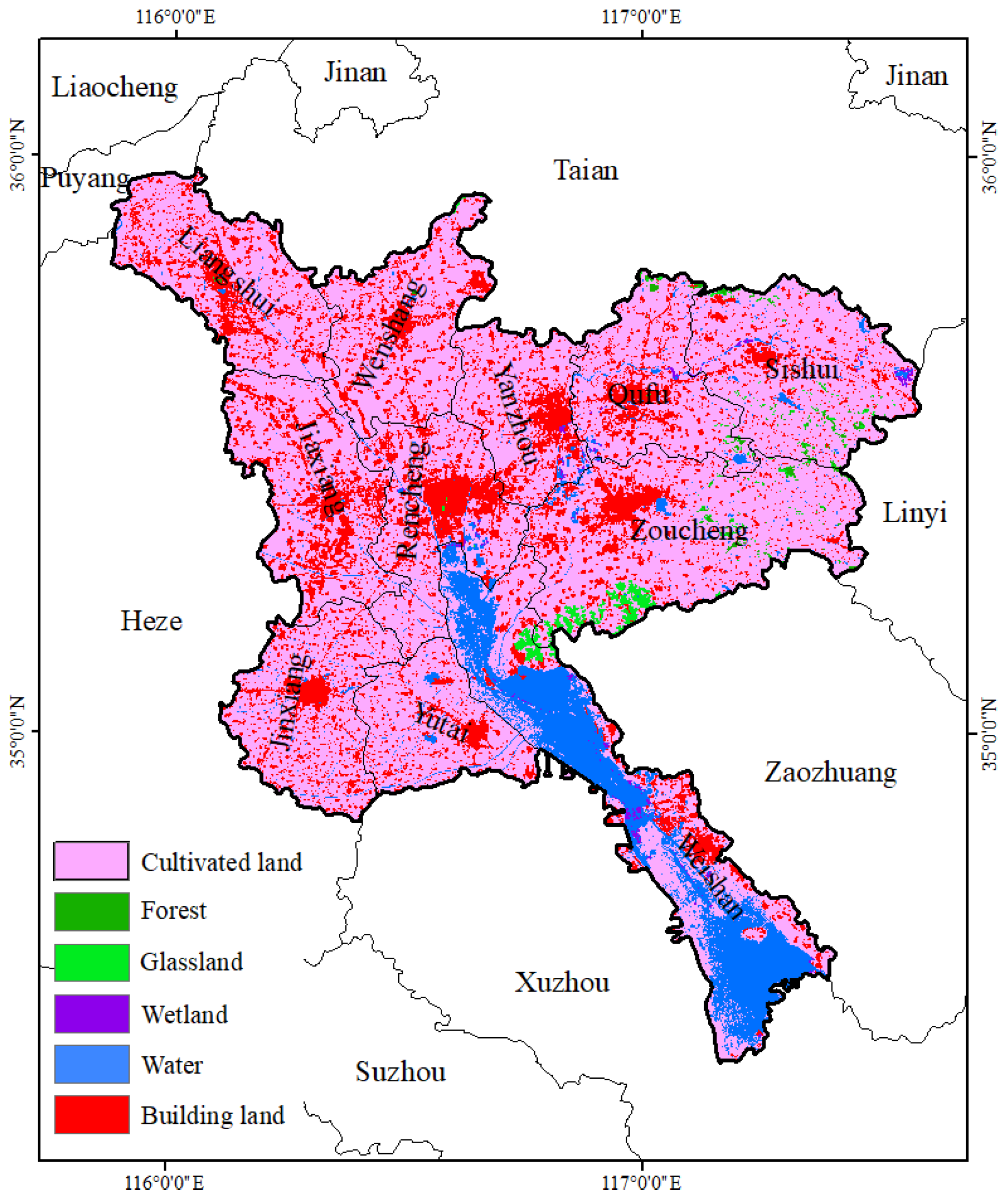

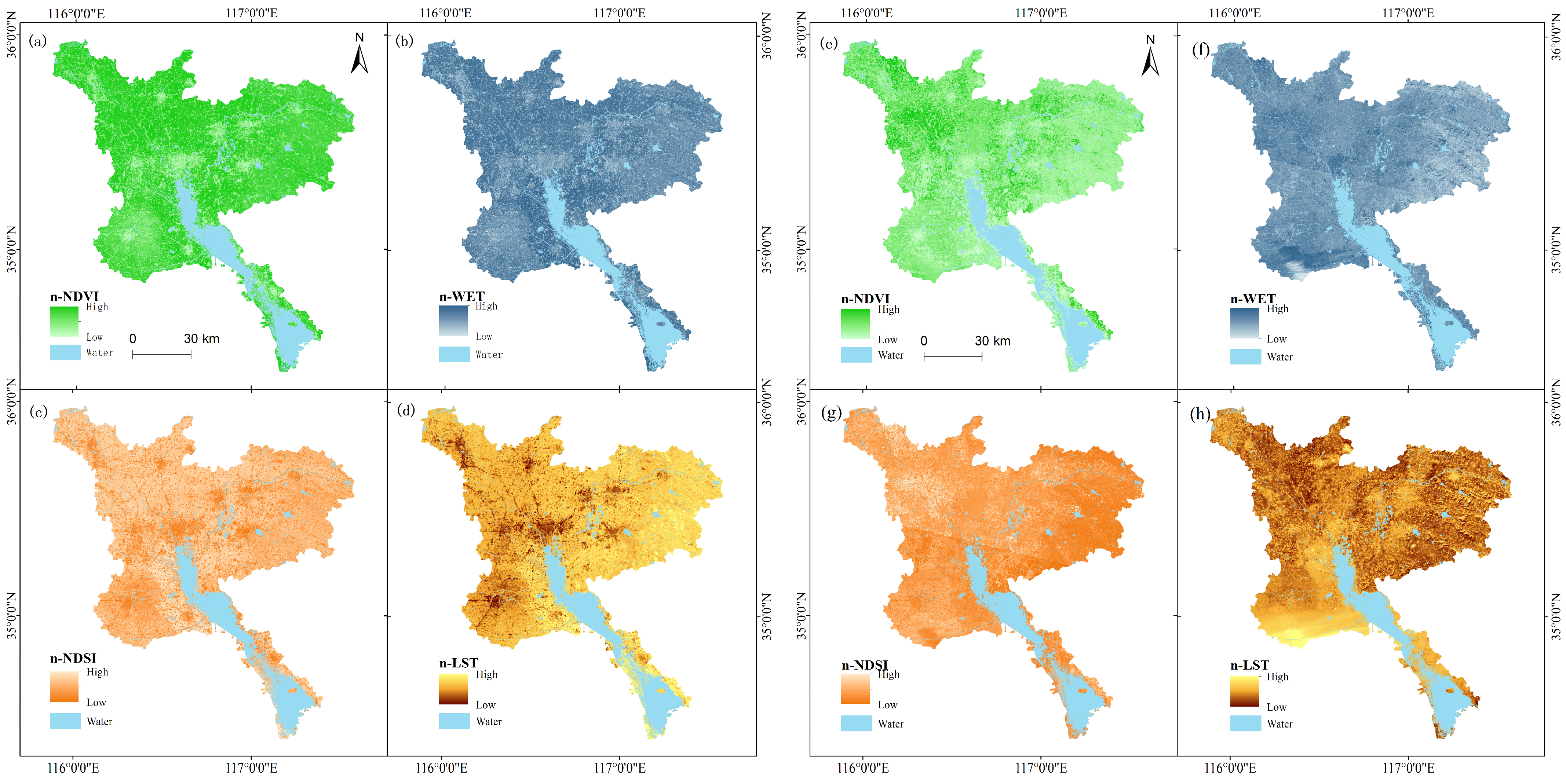
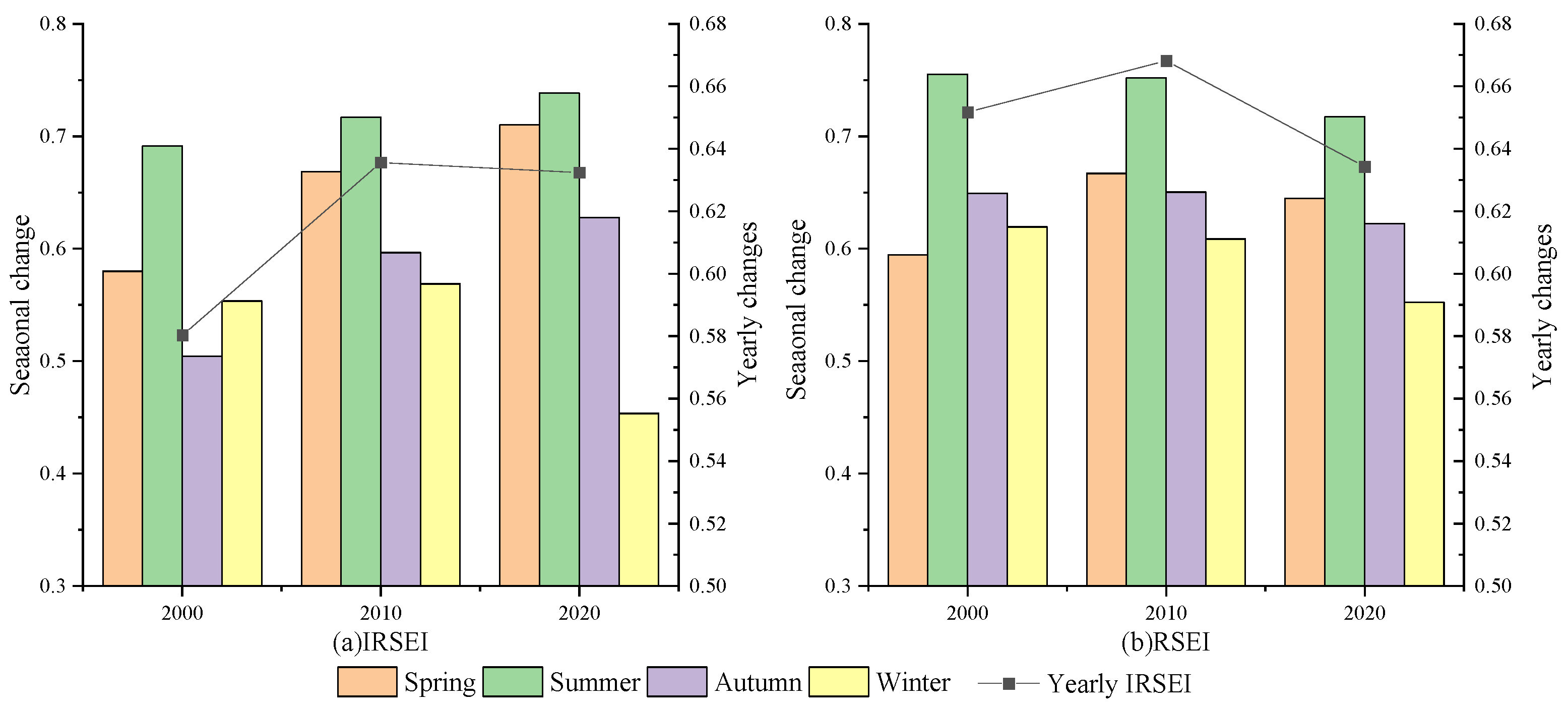
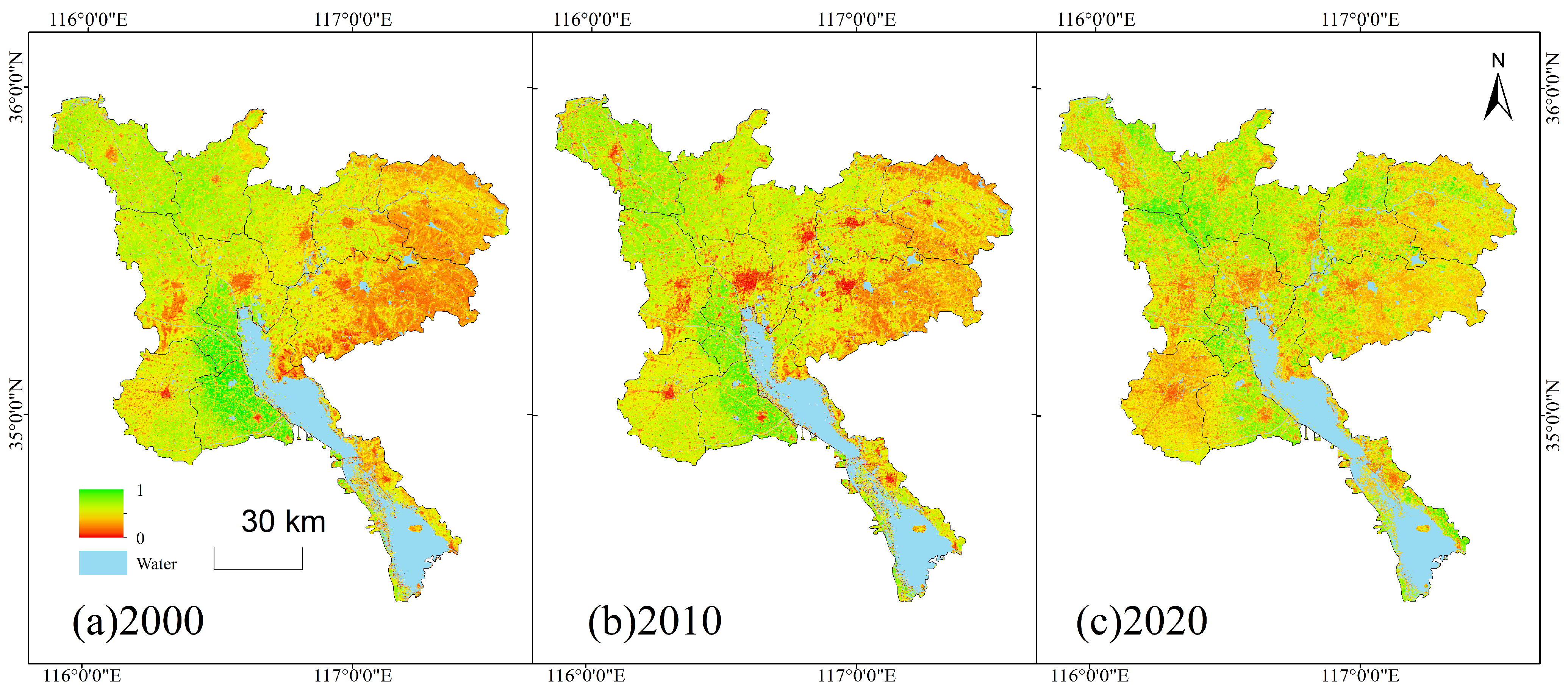

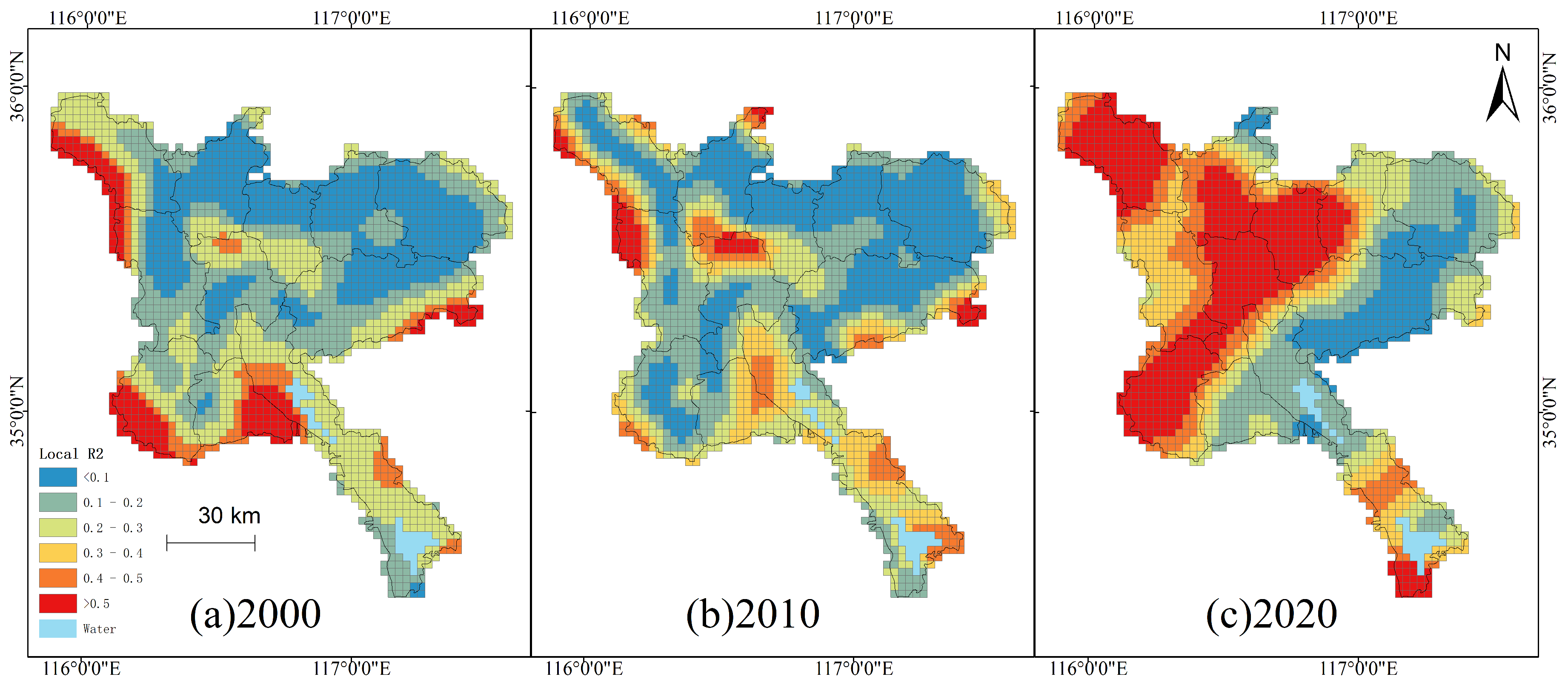
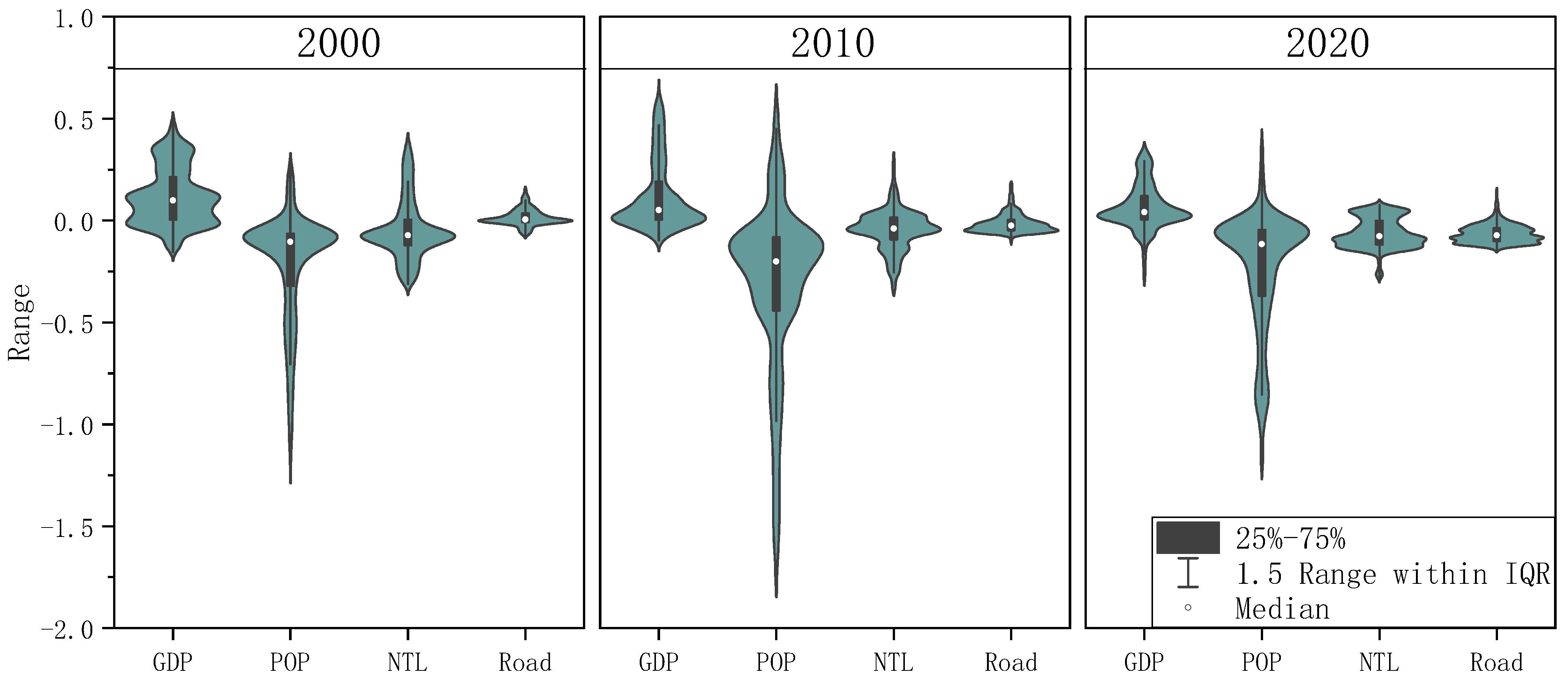
| Data Type | Resolution | Processing and Methodogy | Source | |
|---|---|---|---|---|
| 2000–2020 remote sensing images | 30 m | Geometric correction | Nearest | USGS (https://www.usgs.gov/) (accessed on 2 March 2022) |
| Mosaicking | Nearest Neighbor | |||
| Cropping | - | |||
| JRC Global Surface Water Mapping Layers | 30 m | Cropping | - | JRC JEODPP Data Browser (https://jeodpp.jrc.ec.europa.eu/) (accessed on 5 May 2022) |
| Vectorization | - | |||
| GDP (2000\2010\2019) | 1 km | Formula calculation | - | Resource and Environment Science Data Center (http://www.resdc.cn/) (accessed on 12 July 2022) |
| Cropping | - | |||
| Resampling | - | |||
| Population density | 100 m | Cropping | - | WorldPop (https://hub.worldpop.org/) (accessed on 13 July 2022) |
| Resampling | Bilinear | |||
| Nighttime lighting data (2000\2010\2020) | 1 km | Cropping | - | National Tibetan Plateau Data Center (http://data.tpdc.ac.cn) (accessed on 15 July 2022) |
| Resampling | Bilinear | |||
| Road network data (2020) | 30 m | Formula calculation | - | OpenStreetMap (https://www.openstreetmap.org/) (accessed on 26 August 2022) |
| Cropping | - | |||
| Resampling | Bilinear | |||
| Indicators | Calculation Formula | Explanation |
|---|---|---|
| Greenness | for the near-infrared band and the red band, respectively [7]. | |
| Humidity | correspond to the reflectance of TM and OLI remote sensing images, respectively [7,12]. | |
| Heat | Calculated with reference to [20]. | |
| Dryness | SI represents soil index, IBI represents building index other bands are interpreted as above [7]. |
| NDVI | WET | NDSI | LST | |
|---|---|---|---|---|
| Entropy weight/% | 54.60 | 5.60 | 15.57 | 24.26 |
| Grade Change | 2000–2010 | 2010–2020 | 2000–2020 | |||
|---|---|---|---|---|---|---|
| Area (km2) | Percentage | Area (km2) | Percentage | Area (km2) | Percentage | |
| Better | 3074.21 | 30.90% | 793.67 | 7.99% | 2980.93 | 30.12% |
| Unchanged | 6657.92 | 66.91% | 7733.95 | 77.88% | 6147.59 | 62.12% |
| Worse | 218.11 | 2.19% | 1402.58 | 14.12% | 767.39 | 7.75% |
| Total | 9950.24 | 100.00% | 9930.20 | 100.00% | 9895.91 | 100.00% |
| 2000 | 2010 | 2020 | |||||||
|---|---|---|---|---|---|---|---|---|---|
| Moran’s I | z | p | Moran’s I | z | p | Moran’s I | z | p | |
| 1500 m | 0.573 | 94.653 | 0.000 | 0.542 | 89.591 | 0.000 | 0.567 | 78.566 | 0.000 |
| 2000 m | 0.630 | 47.733 | 0.000 | 0.607 | 46.113 | 0.000 | 0.608 | 46.041 | 0.000 |
| 2500 m | 0.625 | 38.189 | 0.000 | 0.602 | 36.794 | 0.000 | 0.607 | 37.051 | 0.000 |
| 3000 m | 0.609 | 31.247 | 0.000 | 0.585 | 30.012 | 0.000 | 0.588 | 30.132 | 0.000 |
| Model | Scale/km2 | 2000 | 2010 | 2020 | ||||||
|---|---|---|---|---|---|---|---|---|---|---|
| AICc | R2 | R2 Adjusted | AICc | R2 | R2 Adjusted | AICc | R2 | R2 Adjusted | ||
| Geo-weighted regression (GWR) | 1.52 | −8064.885 | 0.636 | 0.619 | −7124.161 | 0.611 | 0.590 | −5102.653 | 0.391 | 0.381 |
| 22 | −3128.020 | 0.430 | 0.420 | −2914.127 | 0.465 | 0.450 | −2571.443 | 0.387 | 0.374 | |
| 2.52 | −2939.980 | 0.695 | 0.664 | −2595.370 | 0.688 | 0.649 | −2216.013 | 0.598 | 0.562 | |
| 32 | −1914.689 | 0.684 | 0.645 | −1724.518 | 0.702 | 0.649 | −1425.883 | 0.589 | 0.544 | |
| Least squares regression (OLS) | 1.52 | −3453.493 | 0.056 | 0.055 | −2753.340 | 0.030 | 0.029 | −2843.504 | 0.038 | 0.038 |
| 22 | −1727.017 | 0.071 | 0.070 | −1271.876 | 0.041 | 0.040 | −1332.177 | 0.049 | 0.048 | |
| 2.52 | −1074.246 | 0.095 | 0.093 | −753.246 | 0.059 | 0.057 | −796.346 | 0.068 | 0.066 | |
| 32 | −691.520 | 0.101 | 0.098 | −465.933 | 0.066 | 0.064 | −498.346 | 0.072 | 0.069 | |
| Driving Factor | Minimum | Median | Maximum | Average | Percentage of Positive | Percentage of Negative | |
|---|---|---|---|---|---|---|---|
| 2000 | GDP | −1.807 | 0.480 | 16.824 | 1.873 | 82.45% | 17.55% |
| POP | −11.506 | −0.568 | 7.721 | 1.530 | 18.56% | 81.44% | |
| NTL | −0.207 | −0.083 | 2.365 | 0.492 | 37.93% | 62.07% | |
| Road | −0.761 | 0.150 | 3.225 | 0.321 | 78.90% | 21.10% | |
| 2010 | GDP | −11.581 | 0.191 | 18.657 | 1.667 | 69.16% | 20.84% |
| POP | −15.002 | −0.328 | 10.985 | 1.391 | 27.44% | 72.56% | |
| NTL | −7.075 | −0.071 | 2.878 | 0.535 | 36.51% | 63.49% | |
| Road | −1.084 | 0.113 | 3.418 | 0.379 | 70.53% | 29.47% | |
| 2020 | GDP | 0.912 | 0.028 | 0.807 | 0.161 | 63.73% | 36.27% |
| POP | −1.295 | −0.144 | 3.717 | 0.320 | 18.81% | 81.19% | |
| NTL | −0.328 | −0.061 | 0.274 | 0.086 | 25.86% | 74.14% | |
| Road | −0.273 | −0.066 | 0.420 | 0.079 | 18.86% | 81.14% |
Disclaimer/Publisher’s Note: The statements, opinions and data contained in all publications are solely those of the individual author(s) and contributor(s) and not of MDPI and/or the editor(s). MDPI and/or the editor(s) disclaim responsibility for any injury to people or property resulting from any ideas, methods, instructions or products referred to in the content. |
© 2023 by the authors. Licensee MDPI, Basel, Switzerland. This article is an open access article distributed under the terms and conditions of the Creative Commons Attribution (CC BY) license (https://creativecommons.org/licenses/by/4.0/).
Share and Cite
Chen, N.; Cheng, G.; Yang, J.; Ding, H.; He, S. Evaluation of Urban Ecological Environment Quality Based on Improved RSEI and Driving Factors Analysis. Sustainability 2023, 15, 8464. https://doi.org/10.3390/su15118464
Chen N, Cheng G, Yang J, Ding H, He S. Evaluation of Urban Ecological Environment Quality Based on Improved RSEI and Driving Factors Analysis. Sustainability. 2023; 15(11):8464. https://doi.org/10.3390/su15118464
Chicago/Turabian StyleChen, Na, Gang Cheng, Jie Yang, Huan Ding, and Shi He. 2023. "Evaluation of Urban Ecological Environment Quality Based on Improved RSEI and Driving Factors Analysis" Sustainability 15, no. 11: 8464. https://doi.org/10.3390/su15118464
APA StyleChen, N., Cheng, G., Yang, J., Ding, H., & He, S. (2023). Evaluation of Urban Ecological Environment Quality Based on Improved RSEI and Driving Factors Analysis. Sustainability, 15(11), 8464. https://doi.org/10.3390/su15118464






